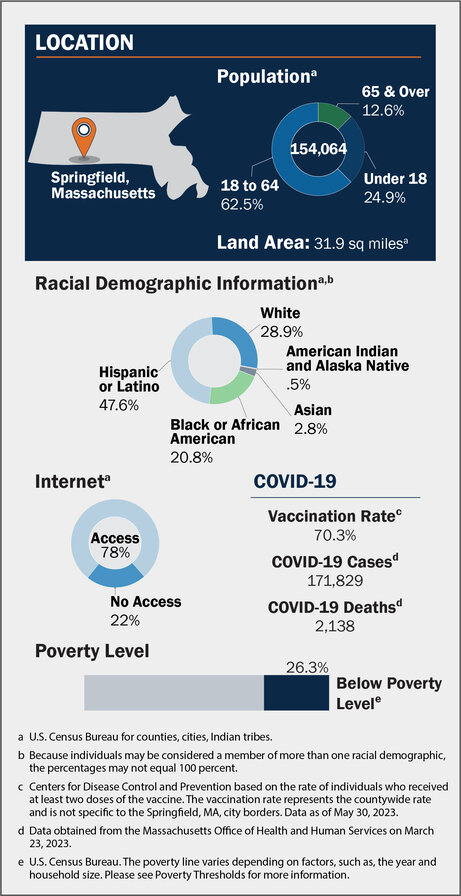Focus on Community: Springfield, Massachusetts
Springfield, Massachusetts was the first of six locations we visited to hear directly from local program administrators, government officials, and other community members about their experiences during the pandemic. Springfield, the third largest city in Massachusetts with a population of 154,064, received more than $1.8 billion across 52 pandemic relief programs and subprograms during the first 18 months of the pandemic. This report provides a closer look at nine of the federal programs that aimed to respond to and ease the effects of the pandemic on the community.
Springfield’s unique experience
Previous experience with several natural disasters and emergency federal aid helped Springfield city officials navigate pandemic assistance programs more easily, so they could quickly put funds to use to help their community. This experience also gave them the necessary knowledge to tailor efforts to their community as well as determine how to spend pandemic and non-pandemic funding more efficiently.
The pandemic disproportionately impacted low-income and minority populations who were working at businesses that had shut down. Springfield’s peak unemployment rate of 21.6 percent in April 2020 was addressed when the federal government provided over $444 million in federal benefits from pandemic-related unemployment insurance programs. Still, the effects of the crisis lingered two years later as underserved communities continued to struggle to secure essential services like childcare which had been affected by increased costs and decreased availability caused by the pandemic.
Federal programs’ impact on the Springfield community
From programs supporting transportation to housing, small businesses to education, city officials used and even repurposed existing federal funding to help respond to the pandemic. For example:
Springfield worked with U.S. Department of Housing and Urban Development (HUD) to use Community Development Block Grant (CDBG) funding to make small business assistance available before federal emergency funding was received. Once CDBG CARES Act funds were available, the city then provided an additional $684,927 to small businesses and non-profit organizations.
With a 50 percent loss in revenue due to the pandemic, the Pioneer Valley Transit Authority used $10.6 million of a $36.6 million grant to maintain operations, provide essential services, and keep staff fully employed.
Representatives of a Springfield nursing home stated that the Provider Relief Fund payments were integral to the nursing home’s pandemic response, including covering the costs of personal protective equipment and staffing.
The federal government funded these programs to ease the effects of the pandemic by addressing community needs that posed a serious threat to the health or welfare of the community. Read the full report on Springfield’s experiences here.
Impact on Communities
To truly understand how the pandemic impacted people on the ground across the country, you have to get out into communities—both big and small, rural, urban and suburban—to appreciate the unique circumstances Americans faced. We did just that, examining six communities across the U.S. The report we reference on this page highlights one of those six communities’ experiences.


